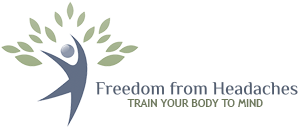“Getting Used to It”…Proprioception
and Accommodation.
In Chapter 2 we talked about habits, how they are formed and how they have an essential role in creating your headaches.
Proprioception and accommodation are closely related to habits. Proprioceptors are specialized nerve endings throughout your body which send information about the state of your body back to your brain. And, proprioception is the term describing why you are able to perceive where your body is in space, the degree of muscle tightness, feelings of pressure, and sensations of temperature, etc. For instance, you are able to walk without looking down at your feet and it’s how you know your hand is in the air and not on your desk when you close your eyes.
It is of particular importance when you suffer from severe headaches as it informs you whether your muscles are tight or relaxed and is a big player in your headache pattern.
As it relates to headaches, proprioceptors allow you to tell whether your muscles are tightening or relaxing. And, when this muscle tension is ongoing your body will accommodate to what that feels like. Accommodation is happening when your shower starts out feeling too hot but you quickly ‘get used to it’ and it also hides ongoing sensations of chronically tense muscles.
Big Reveal: Accommodation keeps you from feeling your tight muscles even though they are causing your headaches.
You notice when something new happens in your body because it feels different, something has changed. Here’s the problem…if the tightening of the muscles of your head, face, jaw or shoulders continues in reaction to a stressor, it becomes a habit. Now the sensation of ‘tightening’ is no longer new and because of accommodation you get used to it and are unaware it’s happening.
The tightening habit is ignored but not the problem it creates…headaches.
Have you gone to the dentist and he says, “Do you know you grind your teeth”, and it’s a surprise? That’s proof you have clenched your teeth to the point there is tooth damage but you were unaware you caused it. This is a familiar scenario in just about everyone we see.
We have talked about how your stress response to external pressure creates increased activity in the Sympathetic Nervous System (SNS) to gear you up for action and part of that gearing up is tightening muscles in your head, neck, face, shoulders, including clenching your teeth.
The longer this goes on it’s easier and easier to do but harder and harder to stop. Because of accommodation, you are no longer aware of proprioceptive sensations of muscle tightening.
Now you can see why so few recognize the significance and importance of a clenching habit and the headaches it helps to generate.
Even if you are aware you are clenching frequently, you may make the mistake of thinking your headaches cause your sore jaw muscles instead of realizing your sore jaw muscles are creating your headaches.
When evaluating a client with severe headaches, it’s not unusual to find chronic muscle tension levels 3, 10, 15 or even 24 times above normal and the client was totally unaware their muscles were so tense and tight. During the evaluation, if asked, “Do you feel relaxed?” The client would invariably say yes! But the objective equipment would say otherwise, to their utter amazement! Accommodation in action.
The beauty of the biofeedback equipment we use, is it’s objective and not subject to the effects of accommodation. Electromyography (EMG) monitors muscles by ‘reading’ electrical activity of the nerves in the muscles that cause them to tighten. This level of muscle tension outside of your awareness due to accommodation and habit is shown to you through a graph, meter or a tone.
We use behavioral interventions because your body’s own innate coping mechanisms are superior to medication for preventing headaches.
Medication is a blunt instrument, it has a whole body effect rather than just treating the specific problem. Behavioral interventions on the other hand are elegant, targeted and recruit your own body’s ability to work for you instead of against you.
You can get used to not having any more headaches!
Now, we have quite a story. At this point the cascade of events leading to your headaches began with something happened, it activated the stress reaction of your ANS, over time it didn’t resolve, these reactions became habits that persisted, you accommodated to them and were unaware they caused the problem you now have…chronic, severe migraines and tension headaches.
To learn more about biofeedback and how muscle tension affects headaches download the free guide, Beyond Relief…Prevention.
The next ‘event’ in the way headaches become chronic is the Myofascial Syndrome and its contribution to chronically tight muscles and headaches. While you may have lost the ability to sense a muscle is tight, you haven’t lost the proprioception of pain.
Don’t miss this one!
Any questions? We love to hear from you.
